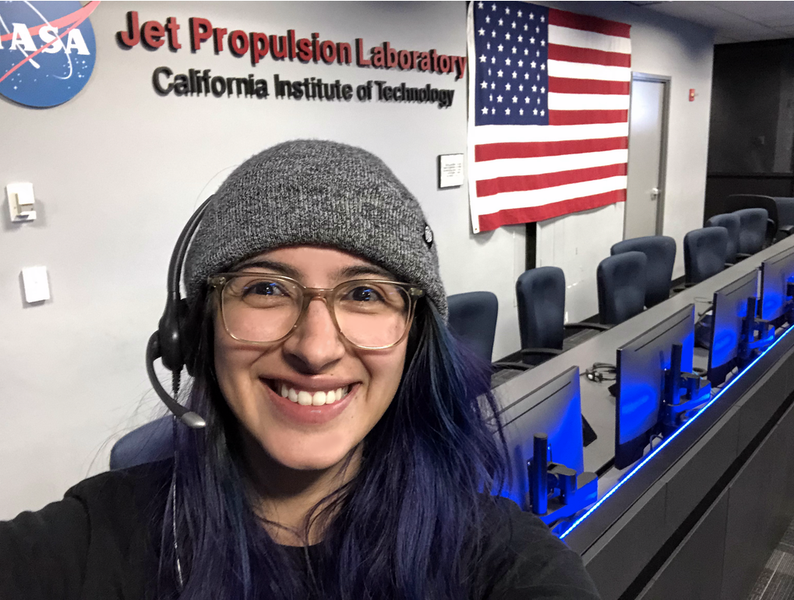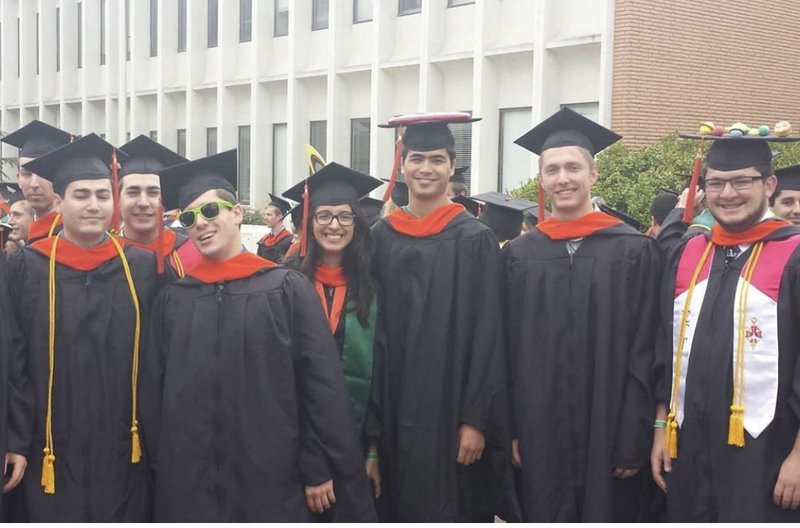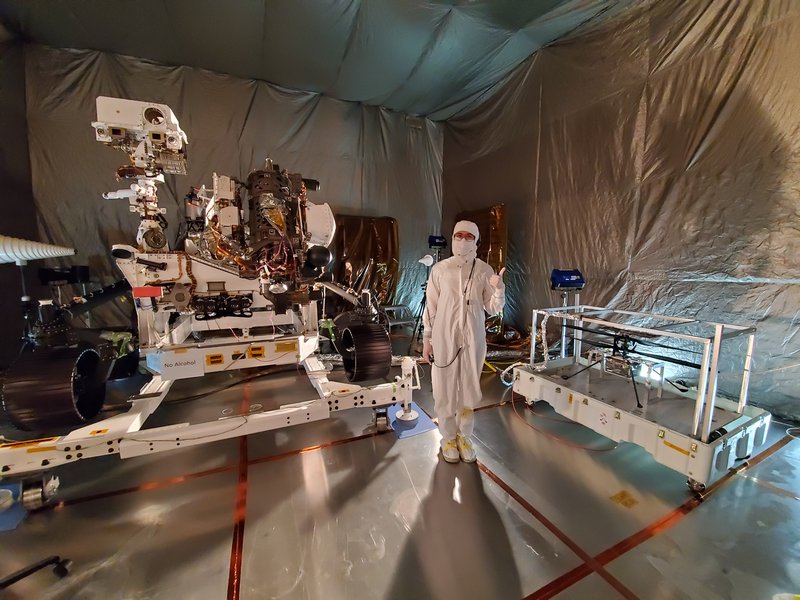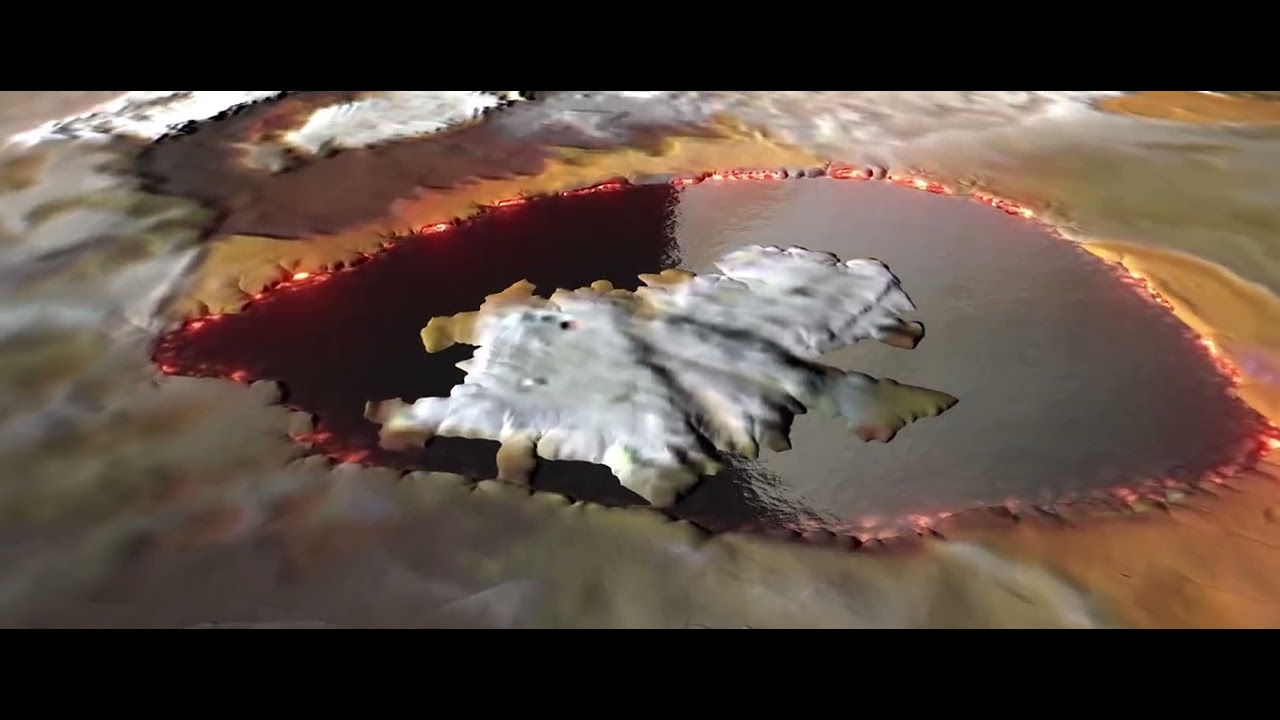9 min read

Christina Hernandez made her way to JPL in 2013, but her challenges from childhood through college shaped who she is today--an engineer for the Mars Perseverance rover on the Planetary Instrument for X-Ray Lithochemistry. The instrument will take super close-up pictures of chemical elements on the Martian surface, to help look for signs of past microbial life.
Below, she sits down to share her struggles with attending college and being Latina, and reveals one of the proudest moments of her life so far.
What was it like to work on Mars 2020?
It’s hard not to get emotional even thinking about it. This rover really means everything. We couldn’t have named it anything better than Perseverance. I often reflect back on not seeing people who look like me in engineering. All of sudden you’re in the room, you’re in the meeting, you’re at the table, you're helping make the decisions, you’re leading the test, you’re in the thick of it. That's when you realize, you’ve made it.
What are your earliest memories of JPL?
My mom took me to a JPL open house one year. But when I was little, my earliest memory of JPL was when I used to sneak out of bed to watch "NOVA" on PBS. It was Wednesdays at 9 p.m., which was way past my bedtime as a kid. Every now and then, there would be an episode on space exploration. There was actually one on Saturn, and they were talking about engineers at the time who were sending a spacecraft called Cassini over to Saturn. This planted the seed. I really don’t think there is another place in the world where you can do the work that we do. It’s always been JPL.
You studied aerospace engineering at Cal Poly San Luis Obispo but said it was a challenging time. What were some of the issues you faced?
When I was in class, I was either the only brown kid, only woman, or both. There are comments that are made, and you feel that you don’t belong and you’re not welcomed. I started to struggle with mental health as a result of the classism, sexism, and racism. This happens to a lot of first-generation college students and students from underrepresented and marginalized communities in STEM. But that entire time, I knew I wanted to work for NASA. I wanted to explore the solar system. It had always been my dream, and I knew I had to figure out a way forward. Luckily, at Cal Poly San Luis Obispo, there was this great program called the Multicultural Engineering Program, and it was really like a beacon of hope on campus for students of color. I also joined the Society of Hispanic Professional Engineers, and I quickly found a group of students who were like me, similar experiences and also struggling through engineering, but together. I had finally found "mi familia" in San Luis Obispo. I was empowered by students who understood the struggle, the obstacles, and the complexities of intersectionality all while being in STEM. All of a sudden, I felt I could get through this. It took a lot of grit and perseverance, but I quickly started to find my confidence in my academics. I ended up graduating with honors, and to me, that was my little comeback story.

What were some of your first projects on Lab?
My thesis work was on orbital debris, so I naturally joined JPL's Natural Space Environment group in the Safety and Mission Assurance Directorate right out of college. My job was to model micrometeoroid environments, perform orbital debris risk assessments for spacecraft, and calculate when our Earth-bound spacecraft reenter at the end of mission, in order to meet the orbital debris mitigation requirements. About a year into working here, I got to work on the tiger team called Comet Siding Spring with Soren Madsen, and that was my introduction to the Mars world. I started on the Perseverance mission over five years, where I was Elizabeth Cordoba's support engineer, who at the time was the instrument engineer for r Radar Imager for Mars' Subsurface Experiment, and Mars Environmental Dynamics Analyzer, which has sensors to measure temperature, wind speed and direction, pressure, humidity and dust size and shape.
When she became the payload lead systems engineer, she handed off those instruments to me, where I took them from pre-critical design review through Assembly, Test, and Launch Operations. And since I learned how to swim in those high-octane environments, I ended up with the Planetary Instrument for X-Ray Lithochemistry instrument, which I got to see through Hardware Requirements Certification Review and eventually will see through to the surface of Mars.
What have been some of your biggest career challenges?
I think sometimes, as engineers, when we think of the word challenge, we think of technical challenge, and there have been plenty of those! But there are also personal challenges. As a Latina, being a woman and being part of the Latinx community, given past experiences, I sometimes felt like I had to try extra hard to prove my worth and make my presence known. I had to take charge of the meeting. I had to be in the problem and part of the solution to make myself feel known and feel like, ‘Hey, I’m here in the room.’ After the Perseverance launch, I did a lot of self-reflection on what it means to be a good leader and team member. I realized that as time progressed, I got to the point where I had established already who I was and what I was capable of doing. I had proven it to myself. I didn't need to prove it to others anymore. I recognized that now I needed to challenge myself to know when it was important to take a step back, amplify others, and allow them to grow. The biggest challenge has been becoming a better team member and learning to become a better team leader.
What are some additional goals that you would like to accomplish?
Since this interview coincides with Hispanic Heritage Month, I would really love to work toward seeing more Latinx engineers in leadership and in technical roles, especially my Latina sisters. It's one thing to get ourselves up there, but another to also help create and retain a continuous flow of engineers who are on the path toward leadership. One of my goals is to advocate for more mentorship and allyship but not just within our community. Our Black, indigenous and LGBTQ+ communities need our community's help in amplifying their voices and goals. I want to help make JPL even more equitable and inclusive.
What does it mean to be Latina?
I grew up not seeing my culture in American history books, and I discovered my culture through my grandmother. You are engrained with this drive of perseverance, hard work, passion, and grit because of the people who come before you. I feel it’s in our blood to be hard working, to be passionate about what we do, and whenever I see that in myself, I always link it back to my roots.
Career-wise, what have been your proudest moments so far?
The moment that I walked into the clean room to get one of the first instruments that I worked on installed on the rover. I never thought I’d be in that room, and it was cool because at the time we had the YouTube live channel and my whole family was able to see me. Going back to launch day, when I saw that countdown and the rocket liftoff, I realized everything that had happened in the past five years. The hardware that we had touched, tested, all the problems, all the successes, all the team happy hours, it was all represented by that rocket launching. I never felt a sense of belonging until that moment.

What are some of your future goals at JPL?
I would love to work on a project and say that I went to each of the planets. I am going to Mars. I’d love to go to Neptune, or even go explore an asteroid, or help out with Earth climate science. I would like to explore the universe, and even though I can’t necessarily be an explorer today, physically out there in space, I can explore through engineering.
What do you like to do in your spare time?
I love to read and I think that’s something that has stayed with me ever since I was little. I’m actually in a JPL book club. We love books so much that now we’re actually running two book clubs. We have a sci-fi book club and then we have a general book club. I have read 40 books this year, so I have surpassed my goal. If I can get to 60 books by the end of year I would be extremely happy.
Do you have any advice for students who are looking to follow in a similar career path?
As engineers, we have to be lifetime learners who are constantly learning and growing every day. Practicing that skill is incredibly important, and you should start as soon as you can. The second thing that I would say is be fearless. Don’t be too afraid of failure. It keeps you humble and properly paranoid. I feel JPL has shown me that there are benefits in failing as long as you learn from it. It teaches you to think critically about how to solve a problem, how to come to a solution, and how to identify what caused the problem. That’s very much JPL bread and butter there.
Answers have been edited for length and clarity.







